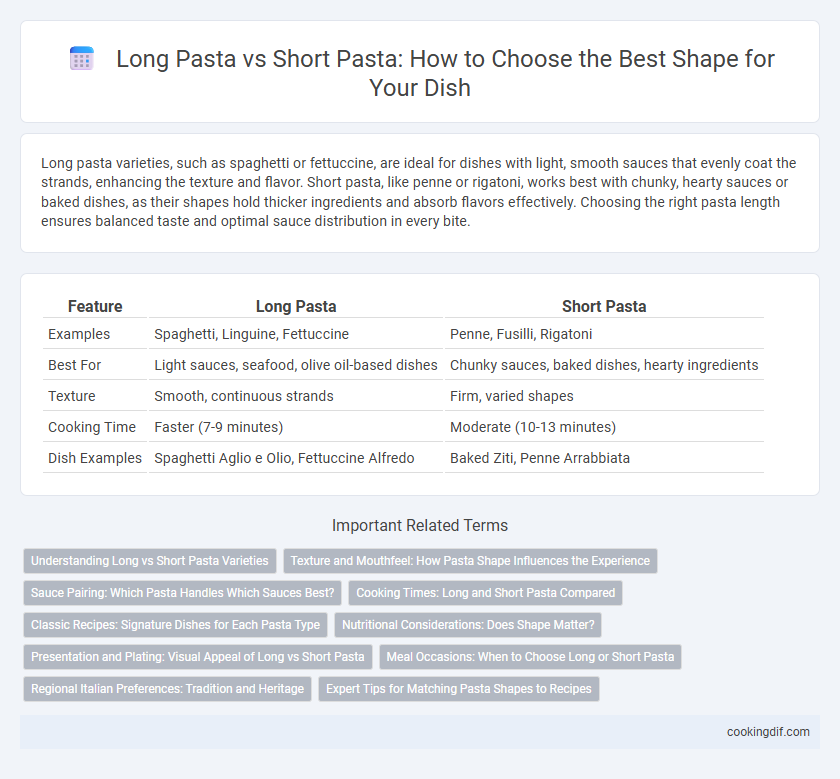Long pasta varieties, such as spaghetti or fettuccine, are ideal for dishes with light, smooth sauces that evenly coat the strands, enhancing the texture and flavor. Short pasta, like penne or rigatoni, works best with chunky, hearty sauces or baked dishes, as their shapes hold thicker ingredients and absorb flavors effectively. Choosing the right pasta length ensures balanced taste and optimal sauce distribution in every bite.
Table of Comparison
| Feature | Long Pasta | Short Pasta |
|---|---|---|
| Examples | Spaghetti, Linguine, Fettuccine | Penne, Fusilli, Rigatoni |
| Best For | Light sauces, seafood, olive oil-based dishes | Chunky sauces, baked dishes, hearty ingredients |
| Texture | Smooth, continuous strands | Firm, varied shapes |
| Cooking Time | Faster (7-9 minutes) | Moderate (10-13 minutes) |
| Dish Examples | Spaghetti Aglio e Olio, Fettuccine Alfredo | Baked Ziti, Penne Arrabbiata |
Understanding Long vs Short Pasta Varieties
Long pasta varieties such as spaghetti, linguine, and fettuccine pair best with lighter, smoother sauces like marinara or olive oil-based dressings, allowing the strands to evenly coat and capture flavors. Short pasta types including penne, rigatoni, and farfalle are ideal for chunky sauces containing vegetables, meats, or cheese because their shapes hold sauce in crevices and tunnels. Selecting pasta based on texture and sauce compatibility enhances the overall dish experience by balancing bite and flavor concentration.
Texture and Mouthfeel: How Pasta Shape Influences the Experience
Long pasta varieties like spaghetti and linguine provide a smooth, continuous texture that enhances the mouthfeel by allowing sauces to coat evenly, creating a harmonious bite. Short pasta shapes such as penne or rigatoni offer a varied texture with ridges and tubular forms that trap thicker sauces, adding a satisfying chew and complexity to each mouthful. The choice between long and short pasta significantly affects the sensory experience, balancing between silky consistency and textured satisfaction.
Sauce Pairing: Which Pasta Handles Which Sauces Best?
Long pasta such as spaghetti, linguine, and fettuccine excel with smooth, thin sauces like marinara, aglio e olio, or creamy Alfredo, as their length allows the sauce to coat evenly. Short pasta varieties like penne, rigatoni, and rotini pair best with chunky, hearty sauces including Bolognese, puttanesca, or vegetable ragu because their shape and ridges trap thicker ingredients effectively. Selecting the right pasta shape based on sauce texture enhances flavor absorption and overall dish harmony.
Cooking Times: Long and Short Pasta Compared
Long pasta varieties like spaghetti and linguine generally require longer cooking times, ranging from 8 to 12 minutes, to achieve al dente texture, while short pasta such as penne or fusilli typically cooks faster, often within 7 to 10 minutes. The thickness and shape of long pasta allow for gradual heat penetration, resulting in even cooking, whereas short pasta's compact form heats more quickly and holds sauces differently. Choosing the appropriate pasta length and shape based on cooking time optimizes meal preparation efficiency and texture consistency in dishes.
Classic Recipes: Signature Dishes for Each Pasta Type
Long pasta varieties like spaghetti and fettuccine pair perfectly with smooth, creamy sauces in classic dishes such as Fettuccine Alfredo and Spaghetti Carbonara, allowing the sauce to coat each strand evenly. Short pasta types, including penne and rigatoni, excel in hearty baked recipes and chunky vegetable or meat sauces like Penne alla Vodka or Rigatoni Bolognese, where their ridges and hollow shapes trap thick, robust flavors. Selecting the right pasta type enhances texture and flavor absorption, elevating traditional recipes to authentic Italian standards.
Nutritional Considerations: Does Shape Matter?
Long pasta, such as spaghetti or fettuccine, and short pasta, like penne or fusilli, have comparable nutritional profiles when made from the same ingredients, with differences primarily in portion size and cooking time. The shape of pasta influences sauce adherence and satiety but does not significantly alter calorie, carbohydrate, protein, or fiber content. Choosing between long and short pasta should focus on recipe compatibility and personal preference rather than nutritional impact.
Presentation and Plating: Visual Appeal of Long vs Short Pasta
Long pasta, such as spaghetti or fettuccine, creates elegant, flowing lines on the plate that enhance visual appeal through length and movement, ideal for dishes emphasizing sophistication. Short pasta, like penne or fusilli, offers a more structured, compact presentation that showcases sauce texture and ingredients, perfect for hearty, rustic plating styles. Choosing between long and short pasta allows chefs to tailor the dish's aesthetic impact, balancing finesse with substance for optimal presentation.
Meal Occasions: When to Choose Long or Short Pasta
Long pasta varieties such as spaghetti and fettuccine work best for light sauces and formal dining occasions, enhancing elegant presentations and delicate flavors. Short pasta like penne and rigatoni is ideal for hearty, chunky sauces and casual meals, allowing sauce to cling within ridges and tubes for maximum flavor. Selecting pasta length depends on sauce consistency and meal formality to create the perfect dish experience.
Regional Italian Preferences: Tradition and Heritage
Long pasta varieties like spaghetti and linguine dominate Northern and Central Italian cuisine, prized for their ability to cling to light sauces and seafood-based dishes common in these regions. Southern Italy favors short pasta shapes such as penne, rigatoni, and orecchiette, which excel at holding robust, chunky sauces like ragu and vegetable-rich condiments emblematic of Mediterranean agricultural heritage. These regional preferences reflect centuries-old culinary traditions that emphasize texture and sauce compatibility essential to authentic Italian gastronomy.
Expert Tips for Matching Pasta Shapes to Recipes
Long pasta varieties like spaghetti and linguine are ideal for thin, oil-based sauces that cling to their strands, enhancing every bite with balanced flavor. Short pasta shapes such as penne, rigatoni, or fusilli excel in capturing chunky, hearty sauces, allowing each piece to hold bits of vegetables, meat, or cheese. Experts recommend matching pasta texture and shape to sauce consistency to optimize dish harmony and improve overall taste experience.
Long pasta vs short pasta for dish selection Infographic

 cookingdif.com
cookingdif.com